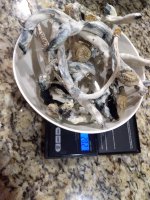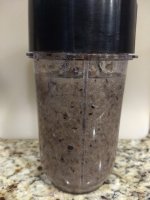Dear nexians, I'm starting to worry about ethyl carbamate possibly being an issue in alcohol tinctures. I can't find any info on this being covered before - which may just be my inability to find what is already out there.
Ethyl carbamate can form by reacting urea with ethanol when heated, but I don't know if the reaction rate goes to 0 at cold temperatures. Ethyl carbamate is a 2A carcinogen according to the International Agency for Research on Cancer which means that it probably causes cancer in humans.
Low levels of ethyl carbamate are permitted in hard liquors (up to 125ppb). Ethyl carbamate can form in fermented products including wine (15ppb limit) and even bread (2ppb) when the yeast releases urea into the alcohol environment. 1ppb = 1 part per billion.
I bring this up because there are references to urea in mushrooms in the literature. One study on Hawaiian magic mushrooms measured up to ~0.5% urea in some magic mushroom species samples (attached, however note that they did not publish P.cubensis urea content I think). This seems like a significant quantity of urea that could be available for reaction with ethanol. Assuming as an example that 0.5% mushroom urea reacts, 3g of mushrooms delivered by alcohol tincture have as much ethyl carbamate as ~3000 shots (30ml) of hard liquor (plus or minus an order of magnitude and needs double checking).
Anyone have more info on this? Hopefully this has already been addressed (if so, sorry I can't find it) or there may be a known reason not to worry about it, such as the reaction equilibrium constant not allowing ethyl carbamate concentrations of the order of a fraction of a percent - so asking for any info anyone may have.
Many thanks.
Ethyl carbamate can form by reacting urea with ethanol when heated, but I don't know if the reaction rate goes to 0 at cold temperatures. Ethyl carbamate is a 2A carcinogen according to the International Agency for Research on Cancer which means that it probably causes cancer in humans.
Low levels of ethyl carbamate are permitted in hard liquors (up to 125ppb). Ethyl carbamate can form in fermented products including wine (15ppb limit) and even bread (2ppb) when the yeast releases urea into the alcohol environment. 1ppb = 1 part per billion.
I bring this up because there are references to urea in mushrooms in the literature. One study on Hawaiian magic mushrooms measured up to ~0.5% urea in some magic mushroom species samples (attached, however note that they did not publish P.cubensis urea content I think). This seems like a significant quantity of urea that could be available for reaction with ethanol. Assuming as an example that 0.5% mushroom urea reacts, 3g of mushrooms delivered by alcohol tincture have as much ethyl carbamate as ~3000 shots (30ml) of hard liquor (plus or minus an order of magnitude and needs double checking).
Anyone have more info on this? Hopefully this has already been addressed (if so, sorry I can't find it) or there may be a known reason not to worry about it, such as the reaction equilibrium constant not allowing ethyl carbamate concentrations of the order of a fraction of a percent - so asking for any info anyone may have.
Many thanks.


